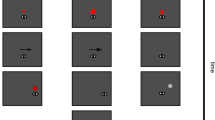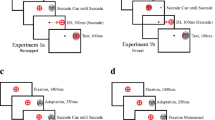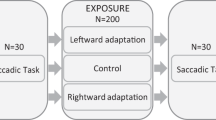Abstract
We examined whether internally triggered saccades made to a nonjumping target (I-saccades) could be adapted independently from externally triggered saccades induced by a jumping target (E-saccades). Five subjects made I-saccades between two fixed targets, one placed straight ahead and the other one positioned at an eccentricity of 17.5°. The peripheral target was displaced to an eccentricity of 8.75° during the saccadic movements toward this target. Amplitudes of the I-saccades made from the central to the peripheral target before and after adaptation were compared with each other. Saccadic amplitudes after adaptation were between 10% and 42% smaller than those before adaptation. E-saccades induced by a single target which jumped from straight ahead to the same peripheral target position as was used for the I-saccades were also measured before and after the adaptation of I-saccades. Amplitudes of E-saccades before and after adaptation were hardly different from each other except in one subject. The mean decreases in amplitude of the two types of saccades, averaged over all subjects, were 21% for I-saccades and 5% for E-saccades. These results show that I-saccades can be adapted to changed visual conditions while E-saccades remain unadapted. We conclude from this finding that I-saccades and E-saccades are generated by at least partially different neural mechanisms.
Similar content being viewed by others
References
Abel LA, Schmidt D, Dell'Oso LF, Daroff RB (1978) Saccadic system plasticity in humans. Ann Neurol 4:313–318
Albano JE, Mishkin M, Westbrook LE, Wurtz RH (1982) Visuomotor deficits following ablation of monkey superior colliculus. J Neurophysiol 48:338–351
Allen DC (1974) Vertical prism adaptation in anisometropes. Am J Optom Arch Am Acad Optom 19:252–259
Becker W, Fuchs AF (1969) Further properties of the human saccadic system: eye movements and correction saccades with and without visual fixation points. Vision Res 9:1247–1258
Bruce CJ, Borden JA (1986) The primate frontal eye fields are necessary for predictive saccidic tracking. Soc Neurosci Abstr 12:1086
Butter CM, Weinstein C, Bender DB, Gross CG (1978) Localization and detection of visual stimuli following superior colliculus lesions in rhesus monkey. Brain Res 156:33–49
Büttner-Ennever JA (ed) (1988) Neuroanatomy of the oculomotor system. (Reviews of oculomotor research, vol 2) Elsevier, Amsterdam
Collewijn H, Mark F van der, Jansen TC (1975) Precise recording of human eye movements. Vision Res 15:447–450
Collewijn H, Erkelens CJ, Steinman RM (1988) Binocular co-ordination of human horizontal saccadic eye movements. J Physiol 404:157–182
Deubel H, Wolf W, Hauske G (1986) Adaptive gain control of saccadic eye movements. Human Neurobiol 5:245–253
Erkelens CJ, Collewijn H, Steinman RM (1989) Asymmetrical adaptation of human saccades to anisometropic spectacles. Invest Ophthalmol Vis Sci 30:1132–1145
Frens MA, Erkelens CJ (1991) Coordination of hand movements and saccades: evidence for a common and separate pathway. Exp Brain Res 85:682–690
Guitton D, Buchtal HA, Douglas RM (1982) Disturbances of voluntary saccadic eye movements mechanisms following discrete unilateral frontal lobe removals. In: Lennerstrand G, Zee DS, Keller E (eds) Functional basis of ocular motility disorders. Pergamon Press, Oxford New York, pp 497–499
Henson DB (1978) Corrective saccades: effects of altering visual feedback. Vision Res 18:63–67
Hepp K, Henn V, Vilis T, Cohen B (1989) In: Wurtz RH, Goldberg ME (eds) The neurobiology of saccadic eye movements. (Reviews of oculomotor research, vol 3) Elsevier, Amsterdam, pp 105–212
Hoyt WF, Daroff RB (1971) Supranuclear disorders of ocular control systems in man: clinical, anatomical and physiological correlations. In: Bach-y-Rita P, Coffins CC, Hyde JE (eds) The control of eye movements. Academic Press, New York London, pp 175–236
Keating EG, Kenney DV, Gooley SG, Pratl SE, McGillis SL (1986) Targeting errors and reduced oculomotor range following ablation of the superior colliculus or pretectum thalamus. Behav Res 22:191–210
Kommerell G, Olivier D, Theopold H (1976) Adaptive programming of phasic and tonic components in saccadic eye movements. Invest Ophthalmol 5:657–660
Kurtz D, Butter CM (1980) Impairments in visual discrimination performance and gaze shifts in monkeys with superior colliculus lesions. Brain Res 196:109–124
Lemij H (1990) Asymmetrical adaptation of human saccades to anisometropic spectacles. PhD thesis, Erasmus University, Rotterdam
Lemij H, Collewijn H (1990) Differences in accuracy of human saccades between stationary and jumping targets. Vision Res 29:1737–1748
Optican LM, Robinson DA (1980) Cerebellar-dependent adaptive control of primate saccadic system. J Neurophysiol 44:1058–1076
Pelisson D, Prablanc C (1988) Kinematics of centrifugal and centripetal saccadic eye movements in man. Vision Res 28:87–94
Pierrot-Deseilligny C, Rivaud S, Gaymard B, Agid Y (1991) Cortical control of memory-guided saccades in man. Exp Brain Res 83:607–617
Robinson DA (1963) A method for measuring eye movements using a scierai coil in a magnetic field. IEEE Trans Biomed Electr 10:137–145
Schiller PH, True SD, Conway JL (1980) Deficits in eye movements following frontal eye-field and superior colliculus ablations. J Neurophysiol 44:1175–1189
Schiller PH, Sandell JH, Maunsel JHR (1987) The effect of frontal eye field and superior colliculus lesions on saccadic latencies in the rhesus monkey. J Neurophysiol 57:1033–1049
Smit AC, Gisbergen JAM van, Cools AR (1987) A parametric analysis of human saccades in different experimental paradigms. Vision Res 57:1745–1762
Snow R, Hore J, Vilis T (1985) Adaptation of saccadic and vestibulo-ocular systems after extraocular muscle tenectomy. Invest Ophthalmol 26:924–931
Tusa RJ, Zee DS, Herdman SJ (1986) Effect of unilateral cerebral cortical lesions on ocular motor behavior in monkeys: saccades and quick phases. J Neurophysiol 56:1590–1625
Wurtz RH, Goldberg ME (1972) Activity of superior colliculus in behaving monkeys. IV. Effects of lesions on eye movements. J Neurophysiol 35:587–596
Wurtz RH, Goldberg ME (eds) (1989) The neurobiology of saccadic eye movements. (Reviews of Oculomotor Research, vol 3) Elsevier, Amsterdam
Author information
Authors and Affiliations
Rights and permissions
About this article
Cite this article
Erkelens, C.J., Hulleman, J. Selective adaptation of internally triggered saccades made to visual targets. Exp Brain Res 93, 157–164 (1993). https://doi.org/10.1007/BF00227790
Received:
Accepted:
Issue Date:
DOI: https://doi.org/10.1007/BF00227790




